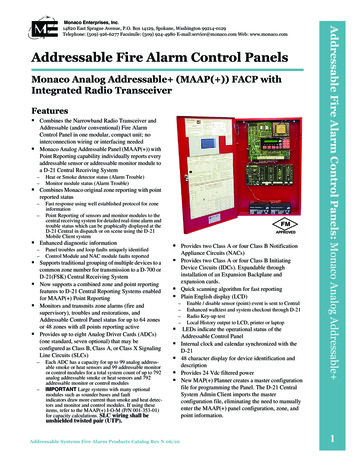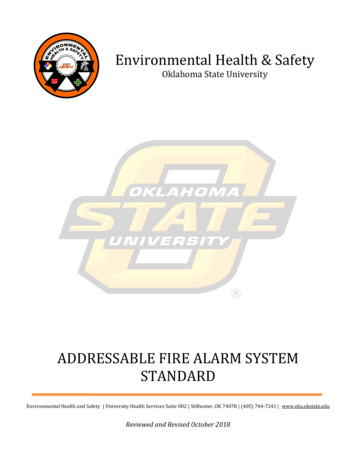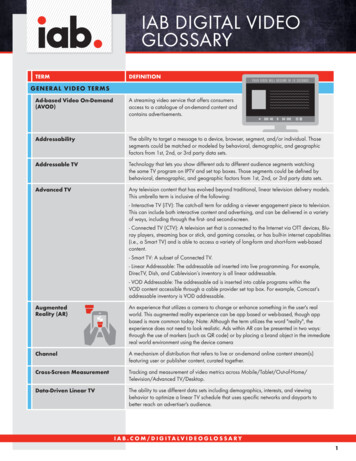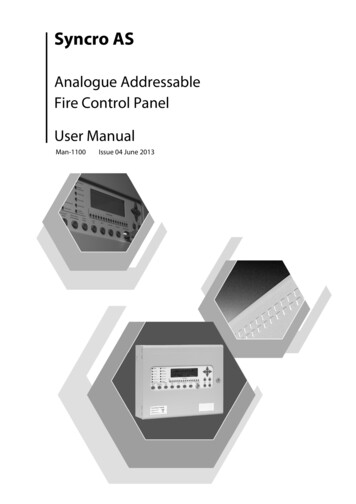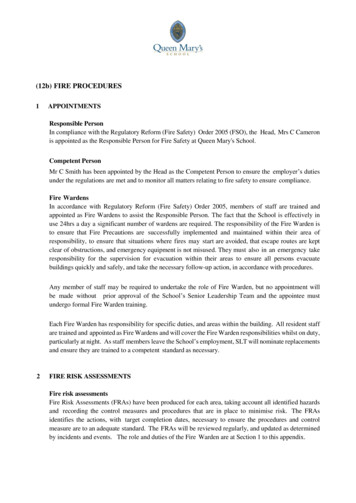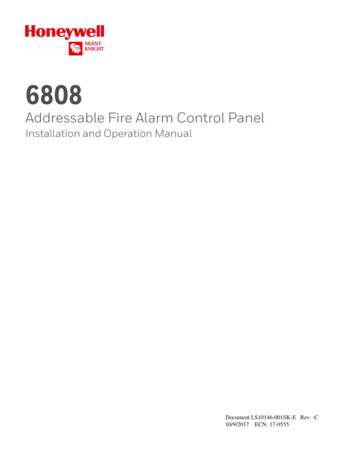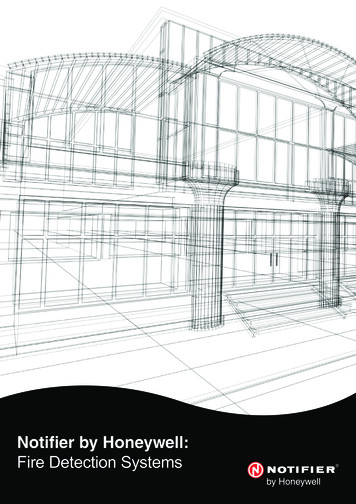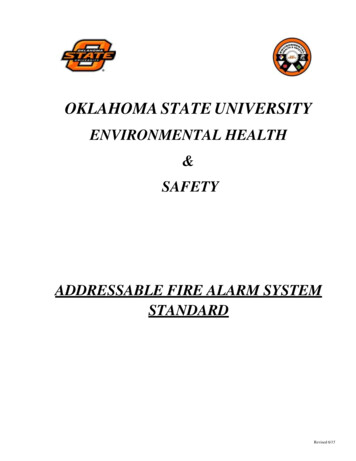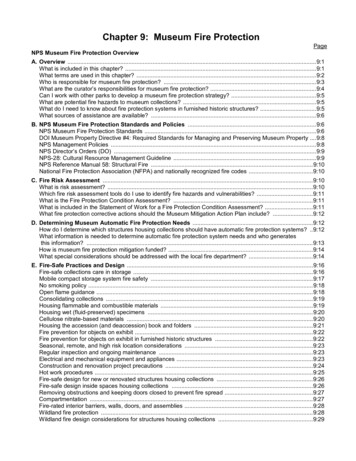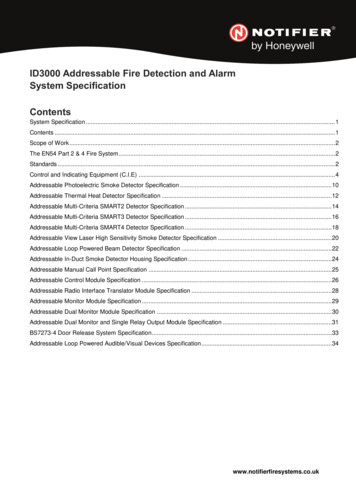
Transcription
ID3000 Addressable Fire Detection and AlarmSystem SpecificationContentsSystem Specification . 1Contents . 1Scope of Work . 2The EN54 Part 2 & 4 Fire System . 2Standards . 2Control and Indicating Equipment (C.I.E) . 4Addressable Photoelectric Smoke Detector Specification . 10Addressable Thermal Heat Detector Specification . 12Addressable Multi-Criteria SMART2 Detector Specification . 14Addressable Multi-Criteria SMART3 Detector Specification . 16Addressable Multi-Criteria SMART4 Detector Specification . 18Addressable View Laser High Sensitivity Smoke Detector Specification . 20Addressable Loop Powered Beam Detector Specification . 22Addressable In-Duct Smoke Detector Housing Specification . 24Addressable Manual Call Point Specification . 25Addressable Control Module Specification . 26Addressable Radio Interface Translator Module Specification . 28Addressable Monitor Module Specification . 29Addressable Dual Monitor Module Specification . 30Addressable Dual Monitor and Single Relay Output Module Specification . 31BS7273-4 Door Release System Specification . 33Addressable Loop Powered Audible/Visual Devices Specification . 34www.notifierfiresystems.co.uk
Scope of WorkTo design, supply and install a Digital Addressable Fire Alarm Detection and Alarm System in accordance with thedetails specified herein and in accordance with supplied drawings.The EN54 Part 2 & 4 Fire SystemThe system shall include all materials, equipment and wiring required to install the complete Fire Detection andAlarm System. The system shall include but not be limited to one or more control panels, repeater panels, anddetectors, call points, audible and visual alarm indicating devices and relays.The installation shall include the laying of all cables required for connection of the detection, alarm indicating andother devices along with connections to the power supply as appropriate to the design. All cabling shall conform tothe requirements and recommendations of the Fire Alarm Control Panel manufacturer. Any openings /chasings inwalls, ceilings or floors shall be fire-stopped as appropriate and made good.The system shall be designed such that no more than 80% of the available signalling / detection loop capacity isemployed to allow for future requirements.StandardsThe fire detection system shall be designed, installed and commissioned in accordance with, and all elements shallmeet the requirements of: BS5839-1: 2013 Code of Practice for automatic fire detection and alarm systems EN54-Part 2: Control and indicating equipment EN54-Part 3: Audible fire alarm devices EN54-Part 4: Power supply equipment EN54-Part 5: Heat Detectors – point type EN54-Part 7: Smoke Detectors – point type using scattered light EN54-Part 8: High temperature heat detectors EN54-Part 10: Flame detection EN54-Part 11: Manual call points EN54-Part 12: Beam smoke detectors EN54-Part 15: Multi-detector fire detectors EN54-Part 17: Isolators EN54-Part 18: Input / Output modules EN54-Part 20: Aspirating smoke detection EN54-Part 23: Visual alarm devices EN54-Part 25: Radio linked devices EN54-Part 26:Point detectors using CO elements EN54-Part 27: Duct smoke detectors BS7671 - IEE Wiring Regulations BS7273 Code of practice for the operation of fire protection measures Part 4: Actuation of releasemechanisms for doorsThe responsible company should be able to demonstrate their competence to design, install and commission thesystem, e.g. by certification to BAFE SP203, LPS1014 or other relevant standard.The equipment manufacturer shall operate a quality management system in accordance with ISO 9001:2000. Inaddition, the equipment shall be manufactured and Third Party Certificated under a recognised factory controlprocedure.All detection devices shall be independently certified as complying with the relevant EN54 standard.The Fire Alarm Control Panel shall be independently certified as complying with requirements of EN54 Part 2 andEN54 Part 4.www.notifierfiresystems.co.uk
The Fire Alarm Control Panel shall be independently certified as complying with requirements of EN54 Part 2 andEN54 Part 4.The Control and Indicating Equipment (C.I.E) shall be independently certified as complying with requirements ofEN54 Part 2 and EN54 Part 4, including any Network devices to connect multiple C.I.E together.In addition to the basic requirements of EN54, the C.I.E shall offer the following EN54 optional features withrequirements:Optional Functions:EN54-2 ClauseIndication7.10.47.138.3Fault signals from fire protection equipmentAlarm counterFault Signals from pointsOutputs Fire alarm devicesFire alarm routing equipmentFire alarm routing equipment with confirmationFault warning routing 27.12.39.510Investigation delays to outputsManual or automatic switching of delays to outputsDependency on more than one alarm signal. Type BDependency on more than one alarm signal. Type CDisablement of pointsTest conditionPower Supply Equipment Functions:Operation from a main power supplyOperation from a standby batteryMonitor and charge the standby batteryRecognise and notify supply faultsEN54-4 Clause5.15.25.35.4The Fire Alarm Control Panel shall also support a number of additional functions that are not covered by EN54.These additional functions shall include: Programmable Cause / Effect on Outputs (E.g. Phased Evacuation)Auxiliary Power Supply OutputAuxiliary Relay Outputswww.notifierfiresystems.co.uk
Control and Indicating Equipment (C.I.E)Functional DescriptionThe main C.I.E (Control and Indicating Equipment) shall contain a microprocessor based Central Processing Unit(CPU). The CPU shall communicate with and control the following types of equipment used to make up the system:intelligent sensors, addressable modules, printers, repeaters, and other system controlled devices. It shall bepossible to changes between the following languages: English (default) – Spanish – Icelandic – Portuguese.FunctionThe main C.I.E shall perform the following functions:Supervise and monitor all intelligent/addressable sensors and modules connected to the system for normal, fault andalarm conditions.Supervise all initiating signalling and indicating circuits throughout the facility by way of connection to monitor andcontrol modules, or direct connection to the C.I.E.Detect the activation of any initiating device and the location of the alarm condition. Operate all indicating appliancesand auxiliary devices as programmed.Visually and audibly, annunciate any fault or alarm condition on the panel display, and repeaters.System Capacity and General OperationThe C.I.E. shall provide, or be capable of expansion to a maximum of eight addressable loops.The C.I.E shall provide, or be capable of expansion to 198 intelligent/addressable devices per loop plus 31 repeatersor mimics per C.I.E.The C.I.E. shall include a fully featured operator interface control and annunciation panel that shall include a backlit240 x 64 pixel Graphics Liquid Crystal Display, individual, colour coded system status LED's, and a keypad for fieldprogramming and control of the Fire Alarm System.The C.I.E. shall meet the requirements of EN54 Pt. 2 and 4 without the need for separate indication LED’s for eachzone of fire. Mandatory annunciation shall be carried out with the use of system status LED’s and the LCD alone.All programming or editing of the existing program in the system shall be achieved without special equipment andwithout interrupting the alarm monitoring functions of the C.I.E.The C.I.E. shall be able to provide the following features: Control-By-Event-By-Time.Day/Night Sensitivity settings.Device Blink Control.Log/Display Reports.Alarm Delays.Non-Alarm Module Reporting.Periodic Detector Test.Non-addressed device detection (address 0).Duplicate address detection.Walk Test.Upload/Download to PC Computer.“Autolearn” facilityClass changeReal Time Display of Analogue Data.Degraded mode of operation“Virtual Keyboard”www.notifierfiresystems.co.uk
Central Processing UnitThe Central Processing Unit shall communicate with, monitor, and control all other modules within the control panel.Removal, disconnection or failure of any control panel module shall be detected and reported to the System Displayby the Central Processing Unit.The Central Processing Unit system shall contain and execute all Control-By-Event programs for specific action to betaken if an alarm condition is detected by the system. Such Control-By-Event programs shall be held in non-volatileprogrammable memory, and shall not be lost even if system primary and secondary power failure occurs.The Central Processing Unit shall contain up to 32 characters of custom alphanumeric location text labels for eachIntelligent Sensor and Addressable Module.The Central Processing Unit system shall contain up to 32 characters of custom alphanumeric location text labels foreach Zone of Fire.The Central Processing Unit shall be capable of being programmed with device and input/output mappinginformation on site without requiring the use of any external programming equipment. Systems that require the use ofexternal programmers or change of EPROM's are not acceptable.The manufacturer's representative shall also be able to program the C.I.E. information, in full, on a P.C. basedsupport tool, which shall make full use of standard Windows features. This support tool shall be able to read thedata from the panel and store it on a portable memory.C.I.E.’s sharing the Central Processing Unit between network processing and fire detection processing are notacceptable.DisplayThe System Display shall provide all the controls and indicators required by the system operator and may also beused to program all system operational parameters.The System Display shall provide a 240 x 64-pixel graphics backlit Liquid Crystal Display (LCD).The “contrast” or “viewing angle” shall be adjustable via the software for optimal viewing in ambient site conditions.The System Display shall provide 15 Light-Emitting-Diodes (LED's) that will indicate the status of the followingsystem parameters. FIRE (2 LED’s), FAULT (2 LED’s), PRE-ALARM, SYSTEM FAULT, SOUNDER FAULT /DISABLED, FIRE O/P FAULT / DISABLED, FIRE O/P ACTIVE, DISABLEMENT, TEST, POWER, DAY MODE,DELAYS ACTIVE, and TECHNICAL ALARM.The System Display shall provide for the addition of 64, 128 or 256 sets of supplementary red Light-Emitting-Diodes(LED's), that will provide warning of fire by zone, and amber Light-Emitting-Diodes (LED's) that will provide warningof fault, disablement and test, by zone.The System Display shall provide a 17-button keypad for entry of any alphanumeric information, and fieldprogramming. Two configurable pass codes will give access to system levels, accessible through the DisplayInterface. An optional Lexan door assembly shall be provided to prevent unauthorised access to the system display.The System Display shall include the following operator control switches: MUTE BUZZER, EXTEND DELAY, ENDDELAYS/EVACUATE, SILENCE/RESOUND, RESET, DAY MODE, FIRE O/P DISABLE, CHANGE TABS, andZONES IN ALARM.Loop Interface BoardsThe C.I.E. shall be supplied as standard equipped with interfaces for two Signalling Line Circuits (SLC)Optional additional Loop Interface Boards (LIB’s) shall be provided to monitor and control two Signalling Line Circuits(SLC Loops) each in the system. The Loop Interface Board shall contain its own micro-controller.For fire systems where the total number of fire input devices exceeds 512, optional Enhanced Loop Interface Boards(E-LIB’s) shall be provided to monitor and control two Signalling Line Circuits (SLC Loops) each in the system. TheE-LIB shall contain its own micro-processor, which shall be capable of continuous monitoring of the SLC in the eventof the main C.I.E. micro-processor failure, and raising an alarm condition when a loop device is in a fire state.www.notifierfiresystems.co.uk
E-LIB’s may be freely intermixed with standard LIB’s within a single C.I.E.The Loop Interface Board shall not require any jumpers, cuts or address switch settings to initialise SLC Loopoperations.The Loop Interface Board shall provide power to, and communicate with, all of the Intelligent/Addressable sensorsand Addressable Modules connected to its SLC Loop over a single pair of wires.The Loop Interface Board shall receive analogue information from all Intelligent Sensors and shall pass thisinformation for processing to determine whether normal, alarm, or fault conditions exist for that particular sensor. Theanalogue information may also be used for automatic sensor testing and for the automatic determination of sensormaintenance requirements.The Loop Interface Board shall communicate with up to 198 Intelligent/Addressable sensors and AddressableModules on each SLC loop and verify proper device function and status.The communications between the Loop Interface Board and the addressable devices will be single fault tolerant inthat a single open circuit-cabling fault will not restrict the operation of the system at all. Limitations due to a shortcircuit cable fault will be dependent on positioning of short circuit isolator modules.A manufacturer’s software tool shall be available to ascertain the loop loading is within functional limitations, basedon cable length and type, loop powered devices themselves, and the distribution of the loop load, accounting for anyrequired spare capacity. Results from this tool shall be used as guarantee that the system shall operate correctlyunder the specified conditions, including a loop open circuit fault whilst operating on low standby batteries.EnclosuresThe control panels shall be housed in a cabinet suitable for surface or semi-flush mounting. Cabinet and front covershall be corrosion protected and in manufacturer's standard finish.The back box shall be constructed of sheet zintec with provisions for electrical conduit connections into the top andbottom.The front cover shall be of a painted Glass Filled Polyester Thermoset Plastic moulding (DMC) with the option of aclear Lexan window to protect the display and controls.The C.I.E. shall be modular in structure for ease of installation and maintenance.It shall be possible to extend the system capacity up to the maximum without the need to replace the original backbox, nor unduly affecting the aesthetics, by the addition of suitable expansion cabinets.PeripheralEach peripheral device connected to the CPU shall be continuously scanned for proper operation. Datatransmissions between the CPU and peripheral devices shall be reliable with high error rejection. The transmissionscheme used should employ dual transmission or other equivalent error checking techniques.Power SupplyThe Main Power Supply shall operate on 230 VAC, 50 Hz, and shall provide all necessary power for the C.I.E.It shall provide 3 amps of user indicating appliance power, using a switching 24 VDC regulator.It shall provide a charger for batteries capable of a minimum of 24 hours of standby.There will be additional power supply units available, of 4.5 and 7.0 amp capacity for larger systems.The 3A or 4.5A supplies shall be capable of being mounted in the same cabinet as the C.I.E, which shall alsoprovide space to house batteries of up to 38 Ah capacity.The 4.5A and 7.0A power supply units shall be capable of being housed in a separate custom enclosure, capable ofadditionally housing batteries of up to 78AH capacity. A further cabinet to house batteries up to 130 AH shall beavailable.A manufacturer’s software tool shall be available to calculate the required battery capacity for the system, based onthe total loading of the system and the standby time required.www.notifierfiresystems.co.uk
System Circuit SupervisionThe C.I.E shall supervise all circuits to intelligent devices, annunciators and conventional peripherals and annunciateloss of communications with these devices. The CPU shall continuously scan devices for proper system operationand upon loss of response from a device shall sound an audible fault, indicate that device or devices are notresponding and print the information on the printer if fitted.Sprinkler system valves and flow switches shall be supervised for “off normal” state.PrinterThe printers shall be of the automatic thermal type, printing the event date and time, device location, event category,and condition.The printer shall be capable of printing a minimum of 80 characters per second.It shall be possible to suspend or disable the printer via action at the primary controls.It shall be possible to “forward” the printer paper by a manual action at the primary controls.The printer shall provide hard-copy printout of all changes in status of the system and shall time-stamp suchprintouts with the current time-of-day and date.Field ProgrammingThe system shall be programmable, configurable and expandable in the field without the need for special tools orelectronic equipment and shall not require field replacement of electronic integrated circuits.All programming shall be accomplished through the standard C.I.E. keyboard or via the off-line P.C. basedconfiguration package.All field-defined programs shall be stored in non-volatile memory.The programming function shall be enabled with a password that may be defined specifically for the system when itis installed. Two levels of user configurable password protection shall be provided.Specific System OperationsSmoke sensor Sensitivity Adjust: Means shall be provided for adjusting the alarm and pre-alarm sensitivity of any orall analogue intelligent smoke sensors in the system from the System keypad. Sensitivity range shall be within theallowed EN54 limits and requirements.Alarm Delays: Each of the intelligent/addressable smoke sensors in the system may be independently selected andenabled to be an alarm delayed sensor. The Alarm delay function shall be programmable for each sensor and shallbe selected during the field programming of the system. The Alarm delay shall not require any additional hardware inthe C.I.E. Configured delay times shall be within the allowed EN54 limits and requirements.Disabling: Any device or zone of devices in the system may be enabled or disabled through the system keypad.When a device is disabled the C.I.E shall continue to monitor the device and shall log fire and fault events, but willnot annunciate or act on those events. Such events shall be distinguishable from those of enabled devices.It shall be possible to disable individual devices or their respective zones when they are in Fire or Pre-Alarm with ashort cut method such that the user need only select from the list of zones or devices in that state at that time.It shall be possible to enable individual devices or zones with a short cut method such that the user need only selectfrom the list of disabled devices at that time.Test: It shall be possible to perform a one person test by zone. Individual output devices shall be capable of beingactivated and de-activated from the control panel for test purposes.A real time tally of the number of devices within the zone, which have been tested, and those remaining untested,shall be displayed on the LCD.It shall be possible to end a zone test with a short cut method.Log/Display Reports: Upon command from an operator, a display of any device shall be provided showing the realtime analogue value.www.notifierfiresystems.co.uk
System History Recording and Reporting: The C.I.E shall contain a History Buffer that will be capable of storing up to600 system input/control events. Each of these events will be stored with a time and date stamp for the actual event.The contents of the History Buffer may be manually reviewed on the LCD or sent to the printer.The History Buffer shall use non-volatile memory. Systems that use volatile memory or battery backed memory forhistory storage are not acceptable.Serially Connected Repeater / Mimic RequirementsThe repeaters and mimic controllers shall communicate with the fire alarm control panel via an RS485 (multi-drop)communications link. Up to 31 Repeaters / Mimic Controllers may be connected to the RS485 communicationscabling.The repeaters / mimics shall require only four wires to provide power and data.Each repeater shall provide full text location detail as indicated at the main C.I.E.The repeater shall provide switches to control MUTE BUZZER, END DELAY/EVACUATE, SILENCE/RESOUND,CHANGE TABS, ZONES IN ALARM, and RESET functions.BatteriesShall be 2x12 volt, Sealed Lead Acid type.Batteries shall have sufficient capacity to power the fire alarm system for not less than twenty-four hours plus 30minutes of alarm upon a normal AC power failure.A manufacturer’s supplied Windows software tool shall be used to provide the calculations required to determinethe minimum battery capacity required for the associated system loading over the expected standby time.NetworkingThe network system shall be third party approved to EN54 part 2 as a distributed C.I.E.The manufacturer shall demonstrate by means of third party documentation that the system meets the requirementthat multiple C.I.E’s are approved as a distributed system and not that individual C.I.E’s are approved containing acommunication interface.FunctionalityThe network shall use a multi token-passing, non-collision-based protocol.A single token shall be used between two stations only and be un reliant on any other token in the system.Two communication links shall be provided on each network node capable of communicating independently of eachother. Each communication links shall be electrically isolated.When the network node receives a message, the message shall be regenerated and error checked before it is retransmitted to the next network node.A priority message system must be provided so that fire response is prioritised above other network messages.Each network node shall have an independent microprocessor dedicated to control of the network. The use of theC.I.E microprocessor for network control is not acceptable.Network distance boosters shall be available if required.Network Capacity and General OperationIt shall be possible to connect up to 125 nodes on the entire network.The network shall be capable of accepting up to 63 C.I.E’s.The propagation delay though any network node shall not exceed 55mS for any message not including low prioritymessages at the time when they may be overtaken at the node by a higher priority message.A single network fault, either open or short circuit between nodes, shall have no effect on the transmission within thenetwork.www.notifierfiresystems.co.uk
The network shall be true peer-to-peer performance and not be reliant on any single node in the system to controlthe network information.The control of the entire network is possible from any C.I.E. in terms of system control functions, Disablements,testing or the display of device statuses including analogue real time value.Supervision of open & short circuit shall be provided between all nodes.Optional earth fault monitoring shall be provided.The network shall be connected in a closed ring. Networks using sub network / stubs or Master/slave architectureare not acceptable.The network system shall provide the capability to synchronise addressable loop sounders across the network.Network CablingThe network cable shall be two core copper cable suitable for the purpose. Fibre optic cable shall be used ifspecified. Fibre optic cable shall be 50/125 or 62.5/125 mm duplex fibre only.One fibre optic card shall be provided per C.I.E as required. The fibre optic card shall be a dual port converter.Use of fibre shall not impose any delay on message.It shall be possible to mix fibre optic and copper cables in each C.I.E. or booster such that any node may convertfrom one media to another.Serially Connected Voice Alarm/Public Address SystemsThe fire detection control panel shall support a programmable serial interface a to a voice alarm system such thatadditional cause and effect can be implemented without the addition of further interface hardware during the life ofthe system.www.notifierfiresystems.co.uk
Addressable Photoelectric Smoke Detector SpecificationCompliance with standardsThe Addressable Photoelectric Smoke Detector shall be third party approved to EN54 part 7.FunctionalityThe Detectors shall use the photoelectric (light-scattering) principal to measure smoke density and shall, oncommand from the C.I.E, send data to the panel digitally representing the analogue level of smoke density.Photoelectric Smoke Detectors shall be intelligent and addressable devices and shall connect with two wires to oneof the C.I.E. Signalling Line Circuit loops.The detector shall operate on a digital protocol loop to give reduced power consumption, upto 99 detectors and 99modules may be connected to a single loop.The detectors shall be fitted with a loop isolation device in-built into the device.Location of devices on the loop circuit shall with the aid of a Loop Mapping Tool be able to identify it’s location andaddress on the loop, allowing for a schematic layout drawing to be produced and printed for use in the O&M manual.The Detectors shall be ceiling-mount and shall include a twist-lock base.Group PollingThe detector shall be capable of group polling with improved performance a result.There shall be no limit to the number of devices that can be grouped together on the same loop.Implementation of group polling feature shall decrease response time for an alarm to be detected to less than 2.5seconds, the use of complex cause and effect programming shall not increase the operation of all output devices tomore than 10 seconds.Test functionsThe Detectors shall provide a means of test whereby they will simulate an alarm condition and report that conditionto the C.I.E.Such a test may be initiated at the Detector itself (by activating a magnetic switch) or initiated remotely on commandfrom the control panel.Address settingThe Detectors shall provide address setting on the Detector head using decimal switches.Addressable Detectors that use binary address setting methods, such as a dip switch, code cards or soft addressingare not acceptable.The Detectors shall also feature an internal identifying code that the C.I.E. shall use to identify the type of Detector.Visual indicationThe Detectors shall provide dual bi-colour LED’s. Both LED’s enable red, amber and green local status indicationalso indicating that the Detector is operational and in regular communication with the C.I.E.The LED’s shall be configurable from the C.I.E to give visual indication of: Device Healthy Fire Fault – Isolation in use Detector Dirty Test Mode Chamber Faultwww.notifierfiresystems.co.uk
If required, the flashing mode operation of the Detector LED’s shall be controlled through the system field program.An output connection shall also be provided in the base to connect an external remote alarm LED.Sensitivity settingsThe Detector sensitivity shall be set through the C.I.E, and shall be adjustable in the field through the fieldprogramming of the system.Sensitivity may be automatically adjusted by the panel on a time-of-day basis.Theses sensitivity levels shall not contravene EN54 part 7 unless placed in to thermal (heat) only mode in whichcase the unit shall comply with EN54 part 5.Drift compensationThe Detector shall automatically compensate for dust accumulation and other slow environmental changes that mayaffect their performance.The use of this function shall not contravene EN54 part 7.
The fire detection system shall be designed, installed and commissioned in accordance with, and all elements shall meet the requirements of: BS5839-1: 2013 Code of Practice for automatic fire detection and alarm systems EN54-Part 2: Control and indicating equipment EN54-Part 3: Audible fire alarm devices
